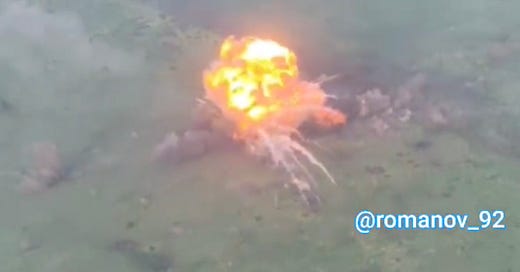Ukraine and The Rise of Robotic Ground Combat
Old Ideas and New Technologies Applied to the Ukraine War (and Beyond)
Earlier this week, an interesting short video emerged of a Russian T-54/55 tank advancing across open ground to assault Ukrainian defensive positions along a tree line (thanks @CalibreObscura). As it advanced, the tank struck a land mine, resulting in a mobility kill (M-Kill), which stopped the tank from moving further. Shortly afterwards, an anti-tank missile was fired at the tank by the Ukrainian defenders.
This resulted in catastrophic explosion. The tank, clearly filled with a large quantity of explosives (reports indicated up to 6 tons although it could have been less), was being operated remotely and was being employed to explosively breach the Ukrainian defensive lines.
This tactic has been repeated in at least one other instance in Ukraine in the last week. As reported by @OSINTTechnical, Russian forces in the vicinity of Marinka employed an MTLB vehicle as a Vehicle Borne IED (VBIED) in attacking Ukrainian defences in a treeline.
It is an interesting tactical adaptation by the Russian forces in Ukraine. But, like nearly everything in war, there are historical precedents in the tactics and technology of these remotely operated armoured vehicles.
Tactical Precedents
Attempting to breach enemy defensive positions – or destroy them outright – with single massive explosions has long historical antecedents. Two modern examples from military history best illustrate this tactic.
During the US Civil War, Union forces exploded a mine to blow a gap in the Confederate defences of Petersburg, Virginia in July 1864. Unfortunately, after the explosion, the tactical situation worsened for the Union attackers. While Union units charged into and around the crater, they were not quick enough to exploit confusion in the Confederate line. The Confederate forces were able to recover from the shock of the explosion and launched counterattacks that sealed off the breach in their lines.
The Union forces were repulsed with severe casualties. They suffered around 500 killed in action, with another 3000 wounded or missing. The creation of a breach in Confederate lines had been successful, but the follow up assault was poorly planned. General U.S. Grant, in command of the Union armies at the time, wrote in his memoirs that:
The effort was a stupendous failure…and all due to inefficiency on the part of the corps commander and the incompetency of the division commander who was sent to lead the assault.
In the First World War, both sides on the Western Front were known to dig deep mines towards enemy trench lines, pack them with explosives and initiate the explosives. This tactic was used on multiple occasions, with one of the best known being during the Battle of Messines in June 1917.
In the months before the battle, specialist tunnelling companies of British, Canadian and Australian soldier dug and 22 separate mine shafts beneath the Messines Ridge. These were packed with tens of thousands of kilograms of high explosive. The Australian official history describes it as follows:
A huge bubble was swelling, mushroom- shaped, from the earth, and then burst to cast a molten, rosy glow on the under-surface of some dense cloud low above it. As its brilliance faded two more bubbles burst beside it. During twenty seconds the same thing happened again and again, from the right to the far left. The nineteen great mine had been exploded… The mines blew vast craters as much as 300 feet in width and 50 to 70 in depth, and each shattered or buried beneath its heaped-up rim the garrison of some 150 yards of trench… enemy resistance was almost absent.
So, there are historical precedents for the contemporary Russian military attempting to explosively blow a hole in their adversary’s defensive lines. The tactic has been used – successfully and unsuccessfully – in previous wars. Success of such a tactic is more assured if the assault forces are able to quickly exploit the destruction and psychological shock caused by the explosion.
Keep reading with a 7-day free trial
Subscribe to Futura Doctrina to keep reading this post and get 7 days of free access to the full post archives.




